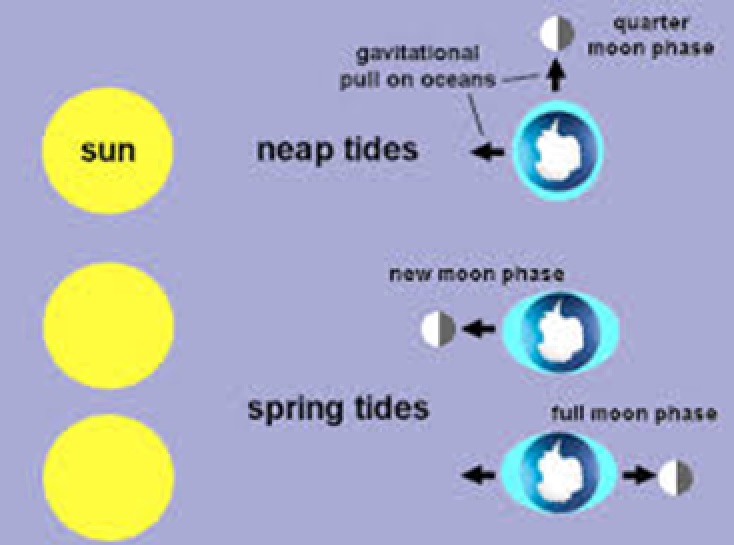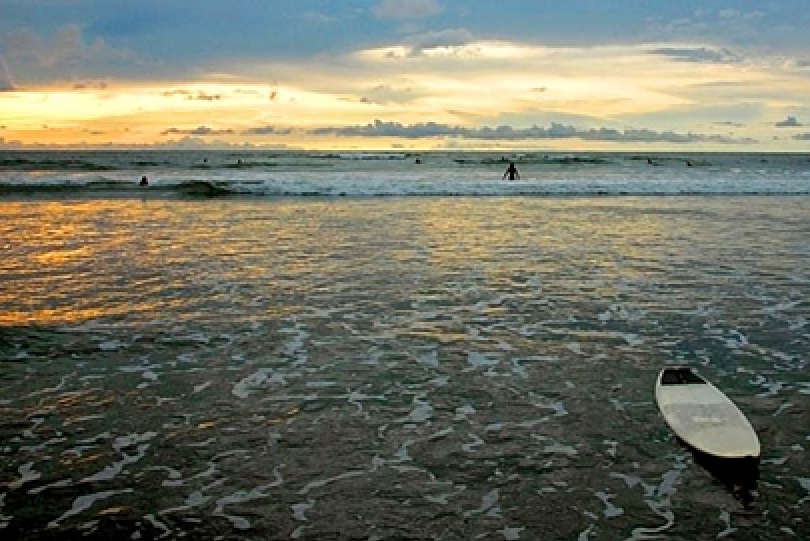You get into Tamarindo just before sunset. As you cruise through town, you notice the ocean is full of surfers riding fun-looking waves and people sitting around on the sand sipping drinks. You head to your Tamarindo vacation rental , unpack, get some dinner, watch a movie with the kids, and call it a night. In the morning, after breakfast, you pack up the fam and head down to the beach. And what a surprise! The water is gone! I mean, the water is still there in the bay, but a huge sandy expanse of beach sparkles in the sun. The waves are small and there aren’t any surfers. What in the world is going on?
Welcome to the Tamarindo tides. The measure of difference between the highest and lowest tide points in this part of the world varies between 6 and 10 feet. It’s not the most drastic difference on the planet, but it makes itself noticed. High tide, low tide—what does it all mean? What time is high tide? Is it dangerous?
Here’s a little “Ocean Science for Non-Science Majors” to help you get your bearings.
First off, what makes the tides?
Tides are caused by the pull of the moon’s gravity. The sun helps too, but the moon does most of the work. You thought all those old-wives-tales about how the moon affects us are just myths? Ha ha. Wait till the tide sneaks in while you’re napping in the sun and steals your favorite sandals. That’ll make you a believer.
Ok. So, the moon creates tides. How?
The moon’s gravity, although you can’t feel it, pulls on the earth. It pulls on everything, with no visible effect on solid things like mountains, deserts, and the house you live in. Water, on the other hand, is another story.
The moon creates tides by causing the water in the oceans to “bulge” out toward it.
At full moon and new moon, when the sun and moon are more or less in a straight line with each other, they work together, and the water in earth’s oceans bulges more. These more dramatic tides are called “Spring Tides,”–unrelated to the season they share a name with. At quarter moons, when the sun and moon are at right angles to each other, the water still bulges, but less. These less dramatic tides are called Neap Tides. This is why, while we always have high tide and low tide, some weeks the tides are more drastic than others.
I know. That’s heavy science for non-science majors. But wait, someone in the back row is raising a hand…
I understand that moon makes the high tides, but…what about low tides?
That’s an easy one.
The volume of water in the world is the same, so when it’s high tide in Tamarindo, it’s low tide somewhere else. As titanicbelfast.com explains, “Tides are caused by the gravity of both the moon and the sun “pulling” at the water in the sea. Because the Earth is constantly turning, the “pull” of gravity affects different places as each day goes on – so when the tide is “out” in your area, it is “in” somewhere else.”
Ok great. But you still didn’t tell me what time high tide is.
In Tamarindo, every 24-hour period has two high tides and two low tides, so the tide is always going either in or out. The high and low tides are about 6 hours apart, (obviously!) but not exactly. The time between the high and low tides is roughly 5 hours and 45 minutes. The result of this is that the high/low tides tomorrow will always be an average of 45 minutes later than high/low tides today. Give or take. It’s cyclical like everything the moon does.
Maybe when you get to Tamarindo, you notice that the tide is high in the middle of the day. That’s great but don’t get too comfy. Five days later, the high tide will be in the late afternoon. Although change is constant, it’s very predictable, and tide charts, with the times of each day’s high and low tides and the anticipated tide height, are available a year or more in advance.
And so is high tide dangerous? Is that when rip currents suck you under?
No, and no. At high tide the water is simply further up on the beach. The safety/danger of the ocean is not directly related to how high or low the tide is at any given moment. That’s a subject for another Ocean Science lesson. So, go for a swim. Have fun. Keep your sandals back from the water. Remember—the tide is always going out or in, so pay attention.
Now, you’re an expert. You’re a savvy, well-educated Costa Rican traveler who knows all about the tides. You pack up the youngsters, check out of your Tamarindo hotel, and head to the Caribbean side of the country, ready to surf the incoming high tide like you did here and…
What? How can this be? There are no tides! Or just barely, anyway. High tide and low tide look pretty much alike as far as you can tell. How in the world is this possible? Is something wrong with the moon?
No. The moon is fine. Follow closely:
Whereas the moon’s gravity creates the tides and determines at what time the high tide and low tide will occur, ocean geography is responsible for how much shift in water height occurs at any given beach. The Caribbean, it just so happens, is famous for extremely small tides. “Compressive geography,” (read, “tight spaces”), not the moon, is responsible for bigger tide ranges.
You don’t mean to be complicated, but you would have thought the curve of the Caribbean was more of a “closed” shape than the Pacific Ocean? This Ocean Science instructor concurs. And yet both of us would be wrong. Costa Rica’s west coast has a much bigger tidal range than the east coast.
Your head is spinning. Is there going to be a test?
No, no test. But if you are assuming that high tide means big waves and low tide means little waves, you’d better make it to the next session of “Ocean Science for Non-Science Majors” class, because you still have lots to learn.








